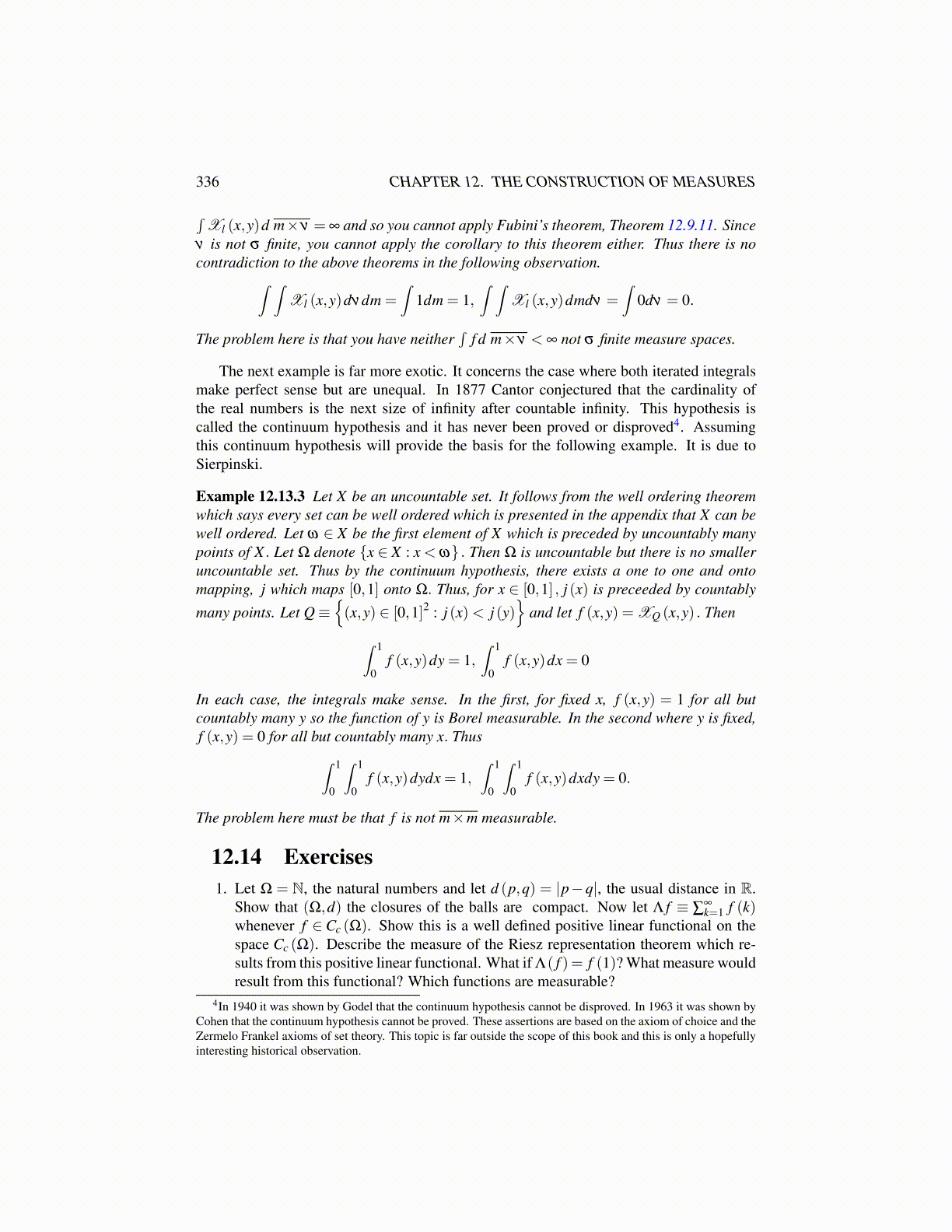
336 CHAPTER 12. THE CONSTRUCTION OF MEASURES
∫Xl (x,y)d m×ν = ∞ and so you cannot apply Fubini’s theorem, Theorem 12.9.11. Since
ν is not σ finite, you cannot apply the corollary to this theorem either. Thus there is nocontradiction to the above theorems in the following observation.∫ ∫
Xl (x,y)dνdm =∫
1dm = 1,∫ ∫
Xl (x,y)dmdν =∫
0dν = 0.
The problem here is that you have neither∫
f d m×ν < ∞ not σ finite measure spaces.
The next example is far more exotic. It concerns the case where both iterated integralsmake perfect sense but are unequal. In 1877 Cantor conjectured that the cardinality ofthe real numbers is the next size of infinity after countable infinity. This hypothesis iscalled the continuum hypothesis and it has never been proved or disproved4. Assumingthis continuum hypothesis will provide the basis for the following example. It is due toSierpinski.
Example 12.13.3 Let X be an uncountable set. It follows from the well ordering theoremwhich says every set can be well ordered which is presented in the appendix that X can bewell ordered. Let ω ∈ X be the first element of X which is preceded by uncountably manypoints of X . Let Ω denote {x ∈ X : x < ω} . Then Ω is uncountable but there is no smalleruncountable set. Thus by the continuum hypothesis, there exists a one to one and ontomapping, j which maps [0,1] onto Ω. Thus, for x ∈ [0,1] , j (x) is preceeded by countably
many points. Let Q≡{(x,y) ∈ [0,1]2 : j (x)< j (y)
}and let f (x,y) = XQ (x,y) . Then
∫ 1
0f (x,y)dy = 1,
∫ 1
0f (x,y)dx = 0
In each case, the integrals make sense. In the first, for fixed x, f (x,y) = 1 for all butcountably many y so the function of y is Borel measurable. In the second where y is fixed,f (x,y) = 0 for all but countably many x. Thus∫ 1
0
∫ 1
0f (x,y)dydx = 1,
∫ 1
0
∫ 1
0f (x,y)dxdy = 0.
The problem here must be that f is not m×m measurable.
12.14 Exercises1. Let Ω = N, the natural numbers and let d (p,q) = |p−q|, the usual distance in R.
Show that (Ω,d) the closures of the balls are compact. Now let Λ f ≡ ∑∞k=1 f (k)
whenever f ∈ Cc (Ω). Show this is a well defined positive linear functional on thespace Cc (Ω). Describe the measure of the Riesz representation theorem which re-sults from this positive linear functional. What if Λ( f )= f (1)? What measure wouldresult from this functional? Which functions are measurable?
4In 1940 it was shown by Godel that the continuum hypothesis cannot be disproved. In 1963 it was shown byCohen that the continuum hypothesis cannot be proved. These assertions are based on the axiom of choice and theZermelo Frankel axioms of set theory. This topic is far outside the scope of this book and this is only a hopefullyinteresting historical observation.